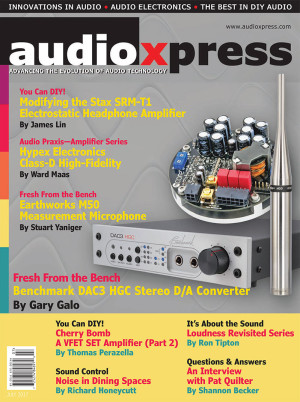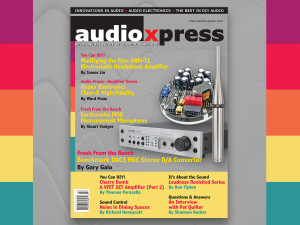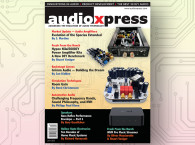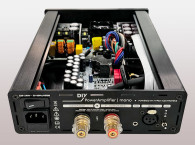 In audioXpress July 2017, we continue our Amplifier Series, exploring the history, recent developments, and new-generation products from some of the most innovative amplifier platform companies serving all segments of the audio industry. This month, Ward Maas writes about Dutch company Hypex, one of the rising stars on amplifier technology since it was founded in 1996. Hypex is mainly known for its Class-D power amplifiers modules and is now one of the top OEM choices for professional audio, studio monitors, and active hi-fi loudspeakers. In this article, we explore the company's Ncore technology, and the Nc 400 amplifier module.
In audioXpress July 2017, we continue our Amplifier Series, exploring the history, recent developments, and new-generation products from some of the most innovative amplifier platform companies serving all segments of the audio industry. This month, Ward Maas writes about Dutch company Hypex, one of the rising stars on amplifier technology since it was founded in 1996. Hypex is mainly known for its Class-D power amplifiers modules and is now one of the top OEM choices for professional audio, studio monitors, and active hi-fi loudspeakers. In this article, we explore the company's Ncore technology, and the Nc 400 amplifier module.Next up, Stuart Yaniger reviews the Earthworks M50 Omnidirectional Measurement Microphone. Earthworks, a well-regarded brand based in the US, manufactures the M series microphones, targeted at the middle of the market, and ranging in price from $500 to $1300 per microphone. The M50 under review ($1299 retail price) is the top entry of the M series, which mainly differs in high frequency cutoff between models.
Another main cover highlight for July 2017 is another review. This time it’s the Benchmark DAC3 HGC Stereo D/A Converter written by Gary Galo. In 2015, Gary Galo reviewed the Benchmark DAC2 DX - review available on the audioXpress website. Much of the technology in the DAC2 and DAC3 converters is the same, but for the DAC3, Benchmark used the new ESS Technology ES9028PRO D/A converter chip, widely recognized in the industry as one of the best DAC chips ever made. Although several other manufacturers of D/A converters and stand-alone digital players have used the new ESS chip, Benchmark’s implementation has ensured the best possible operating environment for the chip and Galo explains why.
Continuing the new article series on Loudness Revisited, in Part 2, Ron Tipton writes about loudness normalization and discusses True Peak and absolute vs. relative loudness measurements. Tipton also addresses some of the free and non-free loudness measuring programs for Windows and Mac, starting with BS1770GAIN and MP3TAG - two free Windows programs; dpMeter II, a free loudness measurement DAW plugin; and MLoudness Analyzer, another free DAW plugin from Melda Production.
In our DIY section, this edition features the second part of the Thomas Perazella’s Cherry Bomb VFET SET Amplifier project, using a very rare Yamaha 2SK77 VFET transistor. The article completes the project, detailing its design and construction. Our second DIY project for the month details how to improve the Stax SRM-T1 electrostatic headphone amplifier. This advanced project, written by James Lin, takes the lessons learned from building the SRX Plus hybrid headphone amplifier, described in audioXpress in November and December 2015. The Stax SRM-T1 electrostatic headphone amplifier was released in 1987, updated to the T1S with balanced XLR inputs in 1993 and to the T1W with extra switching facilities in 1994. The model was always used by Stax for designing headphones, but could not withstand more demanding headphone models. The modifications designed by Lin expand its drive capability and sound quality.
In Sound Control, Richard Honeycutt writes about “Noise in Dining Spaces,” the problem of difficult acoustics in spaces where customers would typically like to engage in normal table conversations but they even have trouble talking to the waiters. The article also addresses how difficult acoustics negatively affect those who wear hearing aids, and problems with noise exposure in school cafeterias.
Our monthly Question & Answer by Shannon Becker is an historic one. We interviewed Pat Quilter, the founder of Quilter Sound Company, better known as QSC. More recently, Pat Quilter decided to also be the "head guru” for Quilter Labs, where he designs and manufactures premiere guitar and musical instrument amplifiers for some of the leading artists and performers in the music industry.
 This month, Richard Honeycutt’s Hollow-State Electronics column continues its focus on guitar amplifiers. In this article, Honeycutt discusses in particular routine maintenance for the classic Ampeg SVT amplifier, one of the most revered tube amps in the market. The article also discusses troubles with the earliest electrolytic capacitors and procuring replacement parts for tube amplifiers.
This month, Richard Honeycutt’s Hollow-State Electronics column continues its focus on guitar amplifiers. In this article, Honeycutt discusses in particular routine maintenance for the classic Ampeg SVT amplifier, one of the most revered tube amps in the market. The article also discusses troubles with the earliest electrolytic capacitors and procuring replacement parts for tube amplifiers.All this is available in audioXpress July 2017, now ready to access and download online. Just visit: www.gotomyxpress.com
Of course you can also subscribe here: www.audioxpress.com/page/audioXpress-Subscription-Services.html
And you can also buy a single printed issue or the complete audioXpress issue archive on USB at www.cc-webshop.com






